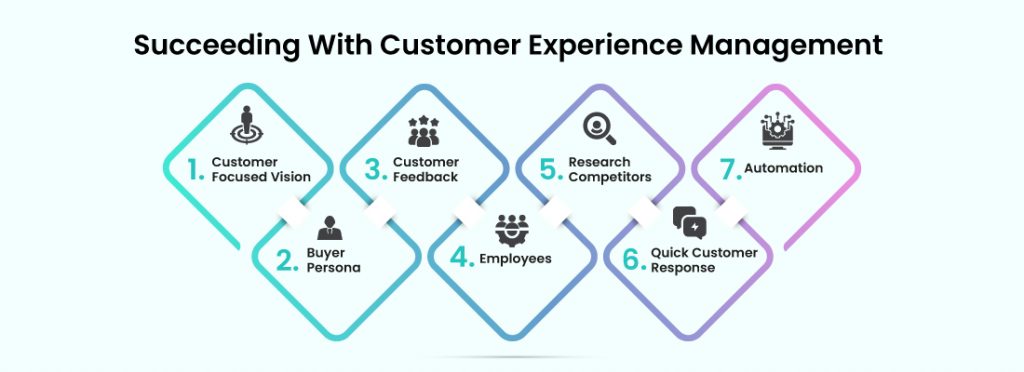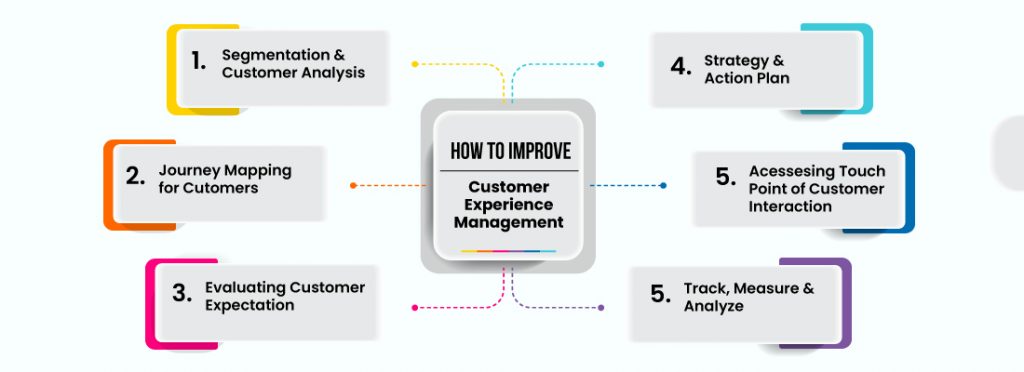Customer experience management (CEM) is getting lots of attention and has integrated itself into the commercial world.
Every company that values its customers is hard at work developing and perfecting a customer experience management strategy.
What is Customer Experience Management, though, and why has it become so popular?
Customer Experience Management, often known as CEM or CXM, is a set of actions taken by a business to give customers a customized, seamless experience.
We’ll go over all you need to know about customer experience management in this article.
Steps for successful customer experience management strategy

Why is managing the customer experience important?
Customer experience stands as an essential brand differentiator that produces a win-win opportunity for both the business and the consumer.
Customers benefit when their requirements are satisfied through customized encounters designed to maximize customer satisfaction.
The customer gains from a richer, fulfilling relationship with the brand as well.
Businesses prosper when they produce more qualifying leads, turn those leads into sales, and then retain the consumer by building lasting brand loyalty.
Customer experience management provides a strategic focus to assist businesses:
Achieve a Deeper Understanding of Clients
Customer experience is indeed not one size fits all. Customers must be earned and kept by providing them with useful, individualized experiences.
This is made possible by audience segmentation using particular consumer information.
The more targeted a service or product becomes, the more revenue the company generates.
Drive Commitment and Loyalty
Simply put, clients that feel seen, understood, and respected stick around.
According to data, these customers spend more money overall, churn less frequently, and recommend businesses to other prospective clients.
Organizations can give smarter service more effectively and efficiently by managing the complete customer journey well.
Maintain a Competitive Edge
Good customer service leads to a successful business. A company’s entire operational success is enhanced by a customer experience focus.
The method is successful in reducing overall expenditures. Businesses that boost customer satisfaction experience significant improvements in sales.
According to research, businesses that provide a superior customer experience outperform their competitors by up to 8% in terms of revenue.
That’s a wise investment: increasing revenue while cutting costs.
Evaluate the Results of Initiatives
Experience management aids businesses in making wiser choices.
Data on customer experiences offers special insight into the actions, ideas, and feelings of consumers.
The data improves the visibility of purchasing decisions.
Businesses can adapt the experience to increase customer engagement after they have a better understanding of how their customers behave.
Tips to implement a successful customer experience management
Create complete customer profiles and customer journey mapping
An effective customer experience depends on having a solid understanding of the attitudes that customers have about a given good, service, or brand.
Businesses need to know their customers more than ever before if they want to provide an excellent customer experience.
Businesses must get to know their consumers in order to effectively market to, sell to, and provide support to them.
This entails developing and keeping up-to-date comprehensive customer profiles that aid in better comprehending and measuring the customers’ journeys via all points of contact across various channels.

The customer journey map underlines all the prospects, pain points, and interactions that companies use to guide CX improvements.
Knowing the customer is essential to providing superior service.
Before a consumer even asks for assistance, organizations can provide an excellent customer service experience by capturing their pain points, characteristics, and features.
By contacting the service team, companies can also predict problems before they happen, offer useful self-help tools, and better meet consumer needs.
Manage and measure CX
Friction points can happen anywhere in the consumer journey —marketing, purchase process, shipping, service or product issues, returns and transactions, payment, online user experience, and more.
Managing CX entails finding and measuring friction spots in the customer journey, figuring out their underlying causes, and fixing the issues once and for all.
Additionally, CX teams should gather feedback from customers across the entire journey to determine where to make improvements.
Brands should utilize consumer sentiment research tools and strategies to comprehend client sentiments rather than relying solely on that data.
The next stage for firms is to develop a system to measure and improve the touchpoints and interactions they want.
This situation typically involves businesses using customer experience software.
The customer experience tool is the system of record and response for experience data.
Customer experience platforms are technologies that let businesses track, monitor, examine, and act on the human input they receive from clients.
Make customer interactions better
By paying close attention to their customers, businesses can improve the customer journey.
A company can obtain a better grasp of consumer behaviors and preferences across all touchpoints once it has a deeper awareness of its target market.
This enables the creation of more precise segments to deliver the very relevant, highly customized experiences that clients desire.
Intelligent customer service management fosters longer-lasting relationships with customers, which increases retention, conversions, and customer loyalty.
Customer Experience Management Vs. Customer Relationship Management
Customer Relationship Management and Customer Experience Management are frequently used interchangeably by business executives and product managers.
This is not the case, though. Let’s investigate how CRM differs from CEM.
The primary objective of CRM includes relationships with customers and optimizing the overall revenue and the company’s growth.
CEM, on the other hand, is concerned with how customers engage and perceive a brand.
Therefore, CRM grasps how a business perceives a customer. What a client thinks about the business is crucial to CEM.
When a customer interaction occurs, such as a sales conversation, support inquiry, or assistance of any kind, CRM comes into play.
On the other hand, CEM is tracked and measured at every point of contact with the client.
Research data, online polls, observational studies, and other methods are used to measure CEM.
Final thoughts
In a nutshell, customer experience management is all about exceeding customers’ expectations and cultivating a positive impression of your business.
Are you searching for a CEM platform for your company?
Start your path towards improving the customer experience with Yugasa Software Labs, a reliable partner that will assist you in gathering feedback, analyzing the data, and closing the loop.
Read More: What is customer service experience and why is it important for business growth?







